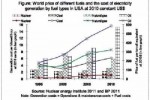
Energy consumption in the world has been stepped up from traditional coal to oil and then to natural gas and nuclear. As per the BP Statistical Review of World Energy 2011, the coal, oil, natural gas and nuclear energy respectively contributed to 27, 30.6, 21.7 and 4.9 per cent to global energy. However, the world reserve ratios of coal, oil, natural gas and uranium are 54: 23: 21: 2.0 respectively indicating that coal will supply almost half of global energy in future. Oil and gas are near to their peaks, but coal will be able to supply energy in the next 118 years at the current rate of consumption, says a report by the World Coal Association.
The World Energy Council estimates a coal reserve of over 860 billion tonnes worldwide, which is equivalent to 439,000 Mtoe (million metric tonnes of oil equivalents). Two-thirds of coal is reserved in the USA, Russia, China, Australia and India accounting to 22.6, 14.4, 12.6, 8.9 and 7.0 per cent, respectively. According to the Power and Energy Sector Roadmap of Bangladesh 2011, the actual coal reserve of the country is approximately 3.0 billion metric tonnes (MT), which is just 0.34 per cent of global reserve. This reserve is distributed into five mines as 390 MT in Barapukuria, 685 MT in Khalashpur, 572 MT in Fhulbari, 1050 MT in Jamalganj and 200 MT Dighipara. Mining started only in Barapukuria in 2005 with an annual extraction target of one million MT to operate a 250 MW power plant. Coal consumption as a whole is very limited because of limited import for brickfields.
Despite a huge domestic reserve of high-quality coal for about 30 years, coal extraction has not been intensified, might be for an over-confidence on the availability of natural gas. It is understood from using gas for brick burning in the early 2000s. Bangladesh is very much dependent on gas to produce 90 per cent power, whereas coal is still the major energy for power generation in the word. However, electricity production has been hampered in the last few years because of insufficient gas supply to the power plants. What the government went for was the oil-operated ad-hoc plants, which already appeared as a big burden on the economy. Now, the government has decided to install coal-run power plants.
Coal is a relatively cheap energy source and power generation from coal is also less costly. BP statistics shows that the price per tonne of crude oil was US$ 583 in 2010, which was $320 for gas and $231 for coal per toe (tonne to oil equivalent) as of the northwest Europe market. The cost of per kilowatt-hour electricity generation was 3.06 cents from coal, 4.86 cents from gas, 2.14 cents from nuclear and 15.18 cents from petroleum at 2010 cents for US plants as per the data of the Nuclear Energy Institute. Here, the generation cost is equal to the operations and maintenance costs and fuel cost. Many other sources also show coal as the cheapest source of energy for power generation.
Only financial viability does not necessary justify the adoption of coal because of its environmental cost. Meanwhile, environmentalists all over the world call coal a dirty energy not for its colour but because it emits CO2. However, the Bangladesh Power Development Board (BPDB) reported an energy-mix for power generation as 75.3, 19.7 and 2.1 per cent from natural gas, oil and coal, respectively for the period July to September 2011. Coal, on the other hand, produces about 41 per cent of electricity in the world, followed by natural gas, nuclear and oil at 21.4, 13.4 and 5.1 per cent, respectively as reported by the International Energy Agency (IEA) in 2011. In this regard, Bangladesh might claim to move for coal for its very low-level emission of CO2. It is to mention here that Bangladesh annually emits 0.3 MT per capita, which is much lower than 1.5 MT and 5.3 MT for neighbouring India and China.
At present, the total and dependable power generation capacity of Bangladesh is 6,887 megawatts (MW) and 5,091 MW respectively that causes a shortfall of 1,674 MW a day. The BPDB’s master plan looks for a generation capacity of 12,120 MW in 2013 which will leave a surplus of 843 MW. This surplus in 2015-16 is expected to be 2,224 MW. By the year 2020, around 40 per cent of the envisaged 20,000 MW will be generated from coal, of which 7,800 MW will be generated from imported coal. The long-term plan, until 2030, says that a total of 8,400 MW will be generated from imported coal and 11,250 MW from domestic coal.
Meanwhile, the government has rolled out a massive plan to set up imported coal-based 10 plants with a total capacity of 7,000 MW. Of which, the government has signed three separate contracts to install three plants with a Bangladesh-China joint venture company. Another agreement has been signed between the BPDB and the National Thermal Power Company of India to install a 1320 MW plant. In addition, the government has started bidding process to construct six more coal-fired plants. Considering the scarcity of fund for investment and import bills, the government has taken the strategy.
However, the question remains how much correct it is to choose the option of imported coal-based power plants. One rationale of the BPDB behind this is the low generation cost, which is about Tk 14 per kilowatt-hour from oil-operated plants and around Tk 4.0 from coal-fire plants. The BPDB data also adds that low-cost coal-fired plants would reduce the increasing supply cost of electricity after December 2013. According to newspaper reports, the plants will use around 20 million MT imported coal a year worth $2.0 billion. Alternatively, if the government does not go for coal, for the same electricity from oil-run plant will cost $8.0 billion at the present rate. These coal-fired power plants are expected to reduce government worries about managing investment and foreign currency reserve.
However, a report in The Financial Express on January 20 shows that the import cost of coal is going to be much higher than anticipated. The C&F cost per tonne of coal stands between $130 and $140 at Chittagong port for coal imported from Indonesia. The cost of coal rises to around $170 per tonne, or Tk 13.94/kg (at $1.0=Tk 82) after charging various fees and port taxes. This price will be significantly higher for upcoming energy crisis. This is not where the story ends. It is widely accepted that none of the ocean-going vessels carrying coal to Bangladesh from the source will be able to berth. Poor navigation in inland waterway besides that will be a costly affair since it will require sustained dredging. To reach this imported coal from port to power plants, the cost of electricity generation will go up further.
Even if the plan for imported coal-fired plants is to be executed, the uncertainty remains on the plants planned with domestic coal. An article published in The Financial Express on February 3 viewed that Bangladesh on its own capability could not mine coal within 20 years. Moreover, the country is not in a position to afford huge investment for coal extraction. Moreover, our environmentalists are concerned of mining method, quality of domestic coal and CO2 emissions. On the other hand, the ministry of law and the ministry of energy have debated on an act or a policy for coal mining. Recently, the prime minister stated that the government is thinking of preserving high-grade coal for future generations.
None of the political or technical or financial obstacles can be overcome, if the government decision led to stopping all endeavour for extraction of domestic coal. Notwithstanding the huge and high-quality domestic reserve, its extraction cannot be started all on a sudden. As per the recent decision, imported coal-based power plants might be expanded for the time being. Quality coal might be imported from Indonesia, but that may not be for a long time as Indonesia has a reserve life of 18 years as reported in Wikipedia. Though the coal of South Africa and Australia is of high quality, it will be expensive. In this case, will we have any option other than to import low-quality coal from neighbouring India?
Dr Aminul Islam Akanda is Associate Professor, Department of Economics, Comilla University. E-mail: [email protected]
https://www.thefinancialexpress-bd.com/more.php?news_id=120535&date=2012-02-18
Aminul Islam Akanda.









